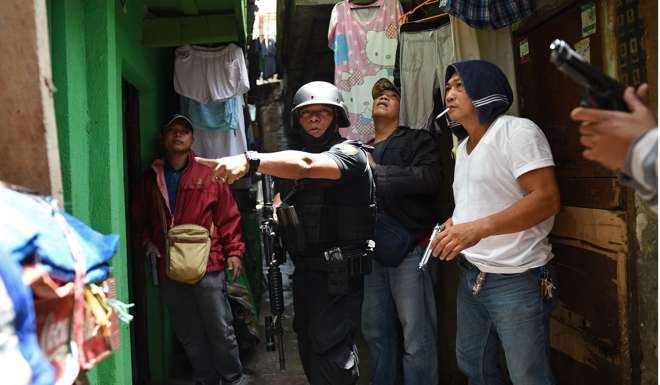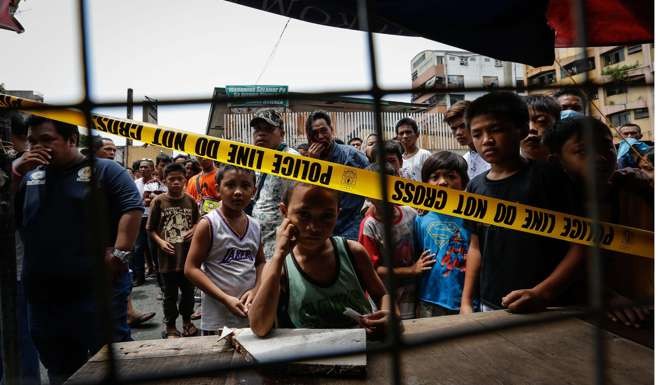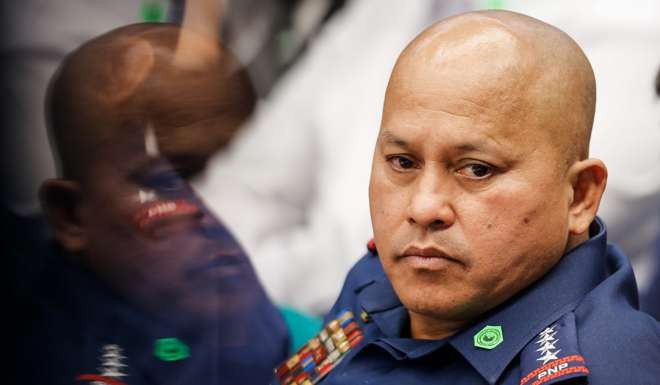
As bodies pile up in Philippines, many fear to talk about Duterte’s war on drugs
The body of 22-year-old pedicab driver Eric Sison lies in a coffin in a Manila slum with a chick pacing across his casket, placed there in keeping with a local tradition to symbolically peck at the conscience of his killers.
Cellphone video footage circulating on social media purports to capture the moment Sison was killed last month when, according to local officials, police were looking for drug pushers in the Pasay township of the Philippines’ capital. A voice on the video, recorded by a neighbour according to newspaper reports, can be heard shouting: “Don’t do it, I’ll surrender!” The sound of gunfire follows.
A poster near the coffin, which lies beside a stinking canal cut between homes, demands “Justice for Eric Quintinita Sison”. A hand-painted sign reads: “OVERKILL – JUSTICE 4 ERIC”.

These are rare tokens of protest against a surge of killings unleashed since Rodrigo Duterte became president of the Philippines just over two months ago and pledged to wage war on drug dealers and crush widespread addiction to methamphetamine.
Last week the number of people killed since July 1 reached 2,400. Duterte’s office did not immediately respond to a request for comment on this report.
Interviews reveal that the police’s Internal Affairs Service (IAS) and the Commission on Human Rights (CHR) are so overwhelmed by the killings that they can investigate only a fraction.
Meanwhile, the popularity of Duterte’s crusade and a climate of fear whipped up by the bloodletting have together silenced dissent from civil society. Even as the death toll rose, a July poll by Pulse Asia put Duterte’s approval rating at 91 per cent.

Anxious reminders by the Catholic Church of the commandment “Thou shalt not kill” make few headlines in the predominantly Catholic country, with newspapers preferring to carry breathless accounts of the latest slayings.
“It’s only the president who can stop this,” de Lima said last week, deploring what she described as the “madness” that led in one case to a five-year-old girl being shot in the head. “How many more of these cases of collateral damage are we willing to bear before we can really start screaming about it?”

Duterte has managed with remarkable speed to nationalise a vicious model for fighting crime that he pioneered as mayor of Davao for 22 years. Rights groups documented hundreds of suspicious murders in Davao on Duterte’s watch and say death squads operated with impunity there. “The Punisher”, as some call him, denies ordering extrajudicial killings but he does not condemn them.
Across the country now, lists of suspected drug pushers are being provided to police by neighbourhood chiefs, adding to a sense of fear and distrust across communities. Politicians of all hues have gone quiet, and a Senate enquiry led by de Lima only has the power to propose legislation, not stop the killers in their tracks.
Chief Superintendent Leo Angelo Leuterio, who heads the IAS, says it is his office’s responsibility to investigate every discharge of firearms involving police. But with only about 170 investigators nationwide, the IAS is able to deal with just 30 per cent of the roughly 30 cases coming in every day.
“Our resources are breaking at the seams,” Leuterio said.

The IAS chief is supposed to be a civilian to ensure its independence but Leuterio is a policeman who spent 13 years of his career in Duterte’s hometown, Davao. He says he is unbiased and has a track record of dismissing hundreds of officers for misconduct.
One person who did come forward is Harrah Kazuo, whose husband and father-in-law were severely beaten and shot dead in a police station, according to a CHR report. She said that when the police entered their home without a warrant they even removed her toddler’s underwear to search for drugs.
Police have not commented on what happened in the home, but two officers have been arrested and charged with murder in connection with the case. Kazuo has been taken into witness protection by the CHR. She is a rare protesting voice in an environment where many are fearful.
Police said they had opened fire that night on a drug suspect in Tondo, a dirt-poor and densely populated district of Manila. When a neighbour was asked how many shots had been fired, he replied: “Sorry, my friend. I didn’t hear a single shot.”

